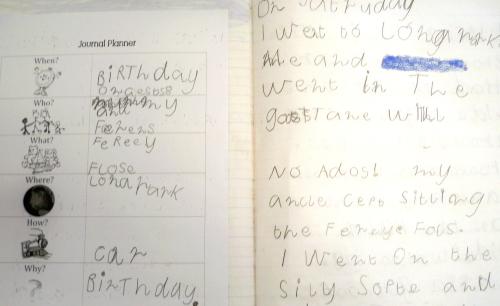Why? & When?
Last year, I decided to develop editing criteria with the children to provide them with a checklist to support their editing efforts. Editing should become a natural part of writing, not a completely teacher driven and controlled process. Writing is a process and there are many models used by teachers. I’ve discovered developing criteria with older and now younger children works best. It’s about handing over the responsibility to the learner.
Having developed criteria with older children, I decided to use the same process with my younger students. I’ve heard teachers talking about ‘dumbing down’ things. It’s not ‘dumbing down’, it’s making teaching and learning relevent the learner’s needs. The children have nearly finished three/quarters of their first year of formal schooling i.e. half way through 2nd semester for international readers. They know a lot about writing, can write, can read and understand and use simple punctuation and audience. These initial concepts need to be in place for children to maximise the benefit from introducing criteria based editing. This process needs to be child understood and owned!
How?
Children need to explore an appropriate piece of writing. I selected a simple piece of writing from CARS Book A which I know is true to form. The selected text contained many of the features I wanted the children to notice i.e. talking marks, commas, capital letters etc… I read the text to the children and we discussed the text. I introduced the word ‘text’. The children were invited to share the reading of the text. Many of my students were able to independently read the provided text.
N.B. I use cheap large sheets of paper for children to record their thoughts in collaborative groups. Large sheets enable children to have space to write and space to stand. It solves some of those problems when children are standing in each other’s space.
Each child was given a copy of the text to explore individually. They were instructed to identify what they thought a good piece of writing needed to contain. They were very industrious and excited when they found and marked spaces etc… Conversation is crucial, hearing the children discuss what they had identified is enlightening and an appropriate time to engage with students, gather prior knowledge and understandings in order to differentiate future teaching and learning tasks / opportunities.



It is interesting to note that this student circled ‘orange’ because it is an adjective-‘coloring in’ word. This child articulated this, and as tmy students have been learning about adjectives, seeing the transfer of what has been taught is fantastic. Some children also circled ‘action words’ or ‘doing words’ which was interesting because we have only looked at these briefly as a class.
I can’t stress how important it is to rove and listen to student conversations, recognise their understanding and question children individually to inform teaching and record learning. The word ‘Tim’ was circled by this child because the student knew that names need capital letters. Some children knew about ‘talking marks’ even though they have only been addressed informally to the grade, and individually at a student’s point of need.
When the children finished looking at the text individually, they shared and recorded what they found in collaborative groups. Groups then shared what they found with the grade while I recorded their findings. The text didn’t contain exclamation marks (‘make it louder marks’) so this was added to the list because my students had been taught about their use and were using them.
The checklist will be used initially for Interactive Writing both teacher and student led. When the children are familliar with the criteria and checklist use, the checklist will be attached to all independent writing. I should also note that now is when I start formal conference appointments with feedback given to children in terms of personal learning goals. Young children are really receptive to contructive feedback and want it! They desire future direction. Using Guided Writing with specific learning goals to meet identified groups is crucial.
Please read Very Young Children Can Edit: Develop criteria, hand over the responsibility and watch them grow. , a post I wrote about how I introduced this in previous years.
Cheers Nina

































